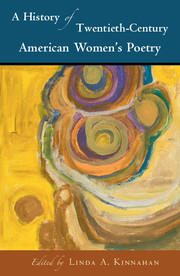Book contents
- Frontmatter
- Contents
- List of figures
- List of contributors
- Preface
- Acknowledgments
- PART I MAPPINGS AND CHRONOLOGIES
- PART II ETHNICITY, RACE, AND IDENTITY
- PART III MATERIAL FORMATIONS
- 10 The World Split Open: Feminism, Poetry, and Social Critique
- 11 Little Magazines and the Gendered, Racialized Discourse of Women's Poetry
- 12 The WP Network: Anthologies and Affiliations in Contemporary American Women's Poetry
- 13 High, Low, and Somewhere In-Between: Women's Poetry and Popular Culture in Modern America
- 14 “At the Edge of What We Know”: Gender and Environment in American Poetry
- PART IV LINEAGES, TIES, AND CONNECTIONS
- PART V FORM, LANGUAGE, AND TEXT
- PART VI CODA
- Bibliography
- Index
10 - The World Split Open: Feminism, Poetry, and Social Critique
from PART III - MATERIAL FORMATIONS
Published online by Cambridge University Press: 05 June 2016
- Frontmatter
- Contents
- List of figures
- List of contributors
- Preface
- Acknowledgments
- PART I MAPPINGS AND CHRONOLOGIES
- PART II ETHNICITY, RACE, AND IDENTITY
- PART III MATERIAL FORMATIONS
- 10 The World Split Open: Feminism, Poetry, and Social Critique
- 11 Little Magazines and the Gendered, Racialized Discourse of Women's Poetry
- 12 The WP Network: Anthologies and Affiliations in Contemporary American Women's Poetry
- 13 High, Low, and Somewhere In-Between: Women's Poetry and Popular Culture in Modern America
- 14 “At the Edge of What We Know”: Gender and Environment in American Poetry
- PART IV LINEAGES, TIES, AND CONNECTIONS
- PART V FORM, LANGUAGE, AND TEXT
- PART VI CODA
- Bibliography
- Index
Summary
“What would happen if one woman told the truth about her life? / The world would split open.” This question, asked by the feminist poet Muriel Rukeyser in her 1960s tribute poem to the German artist and sculptor Kathe Kollwitz, addressed the powerful and life-transforming effect that feminism has had on twentieth-century women. That this comment appeared in a poem also suggests how important women poets have been in voicing and shaping feminist ideologies in the twentieth century.
Speaking through the voice of Kollwitz, Rukeyser presents a verse dialogue between feminism's two main iterations: the 1910s and early 1920s, and the late 1960s and 1970s. Kollwitz's art charted women's struggles before World War I, when modern feminism was emerging in her native Germany and traveling to the United States, where American writer Charlotte Perkins Gillman identified it as “a social awakening of the women of all the world.”
As it did in Europe and Britain, early twentieth-century feminism in the United States took hold as a complex, idiosyncratic movement. Feminism was not just a singular issue – the right to vote which American women finally achieved in 1920. It was an amalgam of competing discourses in which feminists debated. Disparate groups of activists, theorists, artists, and intellectuals discussed new ideas concerning female independence, education, employment, public visibility, and pleasure. They emphasized sexual rights: birth control and companionate “marriage.” Importantly, the external emancipation brought about by the vote and greater economic opportunities was challenged by the need for internal emancipation. Feminists embraced psychology for insight into how to live out these new freedoms. Indeed, as feminist activist Marie Jenney Howe wrote in 1914, “feminism means more than a changed world. It means a changed psychology, the creation of a new consciousness in women.”
Kathe Kollwitz's representations of women's labors, daily anxieties, wartime drudgeries, loves, and losses revealed a woman-centered art made manifest by the arrival of a new feminist movement and consciousness. Rukeyser wrote “Kathe Kollwitz” in 1968, a year of protest in which American women were busy once again organizing for their personal and political rights. By invoking Kollwitz she reminded her readers of first-iteration feminism's unfinished promises, and what a new women's liberation movement might accomplish. She also created a consciously feminist poem, which defined feminist poetry as verse, which, regardless of style, interrogates the central question of what it means to be female.
- Type
- Chapter
- Information
- A History of Twentieth-Century American Women's Poetry , pp. 155 - 169Publisher: Cambridge University PressPrint publication year: 2016

